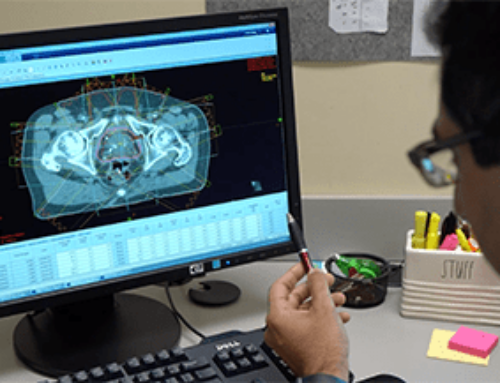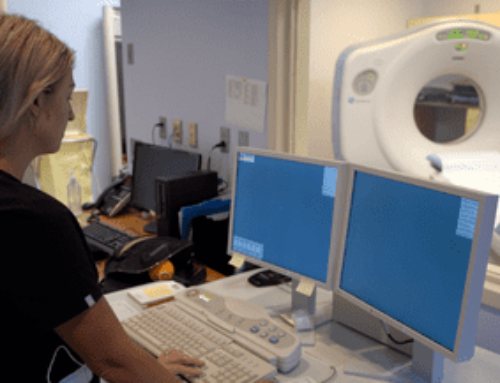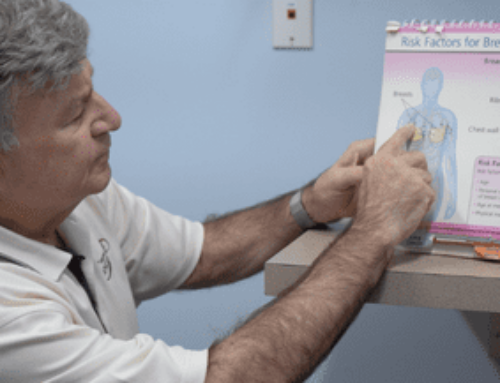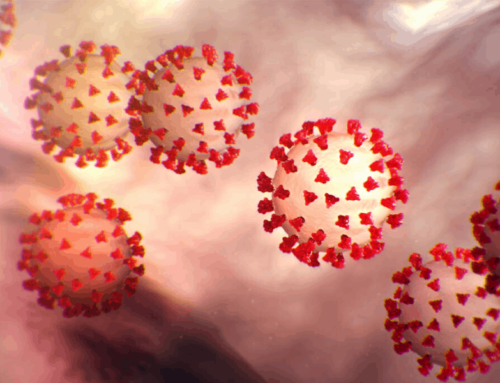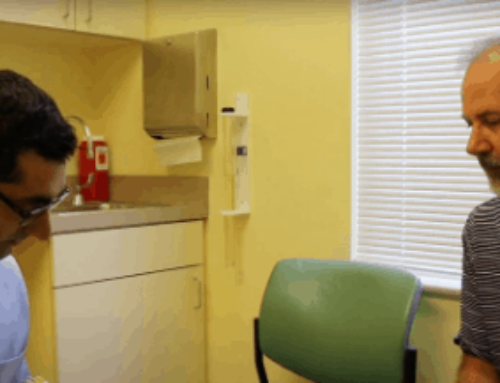- What is breast cancer in men?
- How is male breast cancer different from female breast cancer?
- What are the challenges of diagnosing breast cancer in men?
- What are the symptoms of breast cancer in men?
- How is male breast cancer diagnosed?
- How is breast cancer in men treated?
- Are you at risk for male breast cancer?
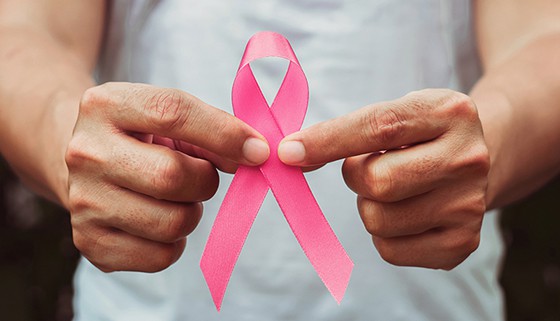
The pink ribbon is a powerful symbol of our efforts to cure breast cancer in women, which remains one of the most common cancers in the United States. During October, we proudly display these badges of solidarity to show support for the thousands of women who struggle with this disease. With broader awareness comes greater support, and we’ve made great strides in the early detection and treatment of breast cancer.
However, because breast cancer predominantly affects women, we often overlook cases of the disease in men. As a consequence, you may be surprised to learn that 500 men in the U.S. will die from breast cancer this year alone.
This article will look at breast cancer in men to shed some light on a disease that is both rare and life-changing.
What Is Breast Cancer in Men?
Cancer can occur anywhere there are cells in the body. In breast cancer, cells begin to mutate and spread rapidly within the chest tissue. As these cells accumulate, they form tumors, which are dense masses of extraneous tissue. If the cancer cells become malignant, they can metastasize, spreading to other body parts.
Problems arise when these masses put pressure on the body’s internal systems or interrupt the biological processes we need to function. In some cases, the disruption can be fatal.
Breast cancer in males is rare, with one out of every 100 cases of this disease occurring in men.
How is Male Breast Cancer Different from Female Breast Cancer?
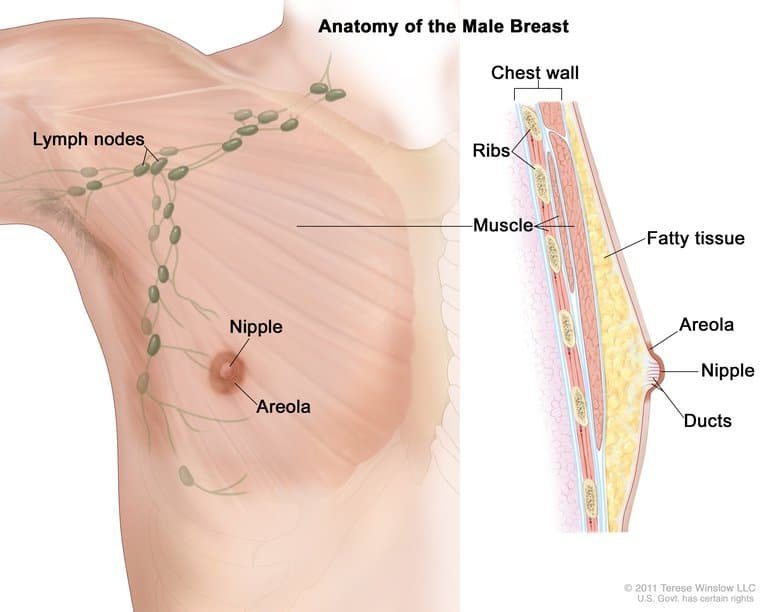 Despite differences in appearance, a man’s breast tissue consists of the same tissues and organs as female breasts. For both men and women, the breast is comprised of:
Despite differences in appearance, a man’s breast tissue consists of the same tissues and organs as female breasts. For both men and women, the breast is comprised of:
- Areola (nipple)
- Breast cells
- Ducts
- Fatty tissue
- Lymph nodes
Additionally, men and women also share the same genetic risk factors for breast cancer, including the BRCA1 and BRCA2 DNA markers that signal a higher probability of developing the disease. However, in men, these genetic mutations can also indicate a higher risk of prostate cancer.
Because men have less fat and fibrous breast tissue (known as stroma), they are less likely to develop breast cancer. Unlike men, as girls mature into women, they develop active lobules and milk ducts to produce milk during childbirth. These tissues are more prone to develop cancer over time. Estrogen, which occurs in higher levels in women, is also thought to contribute to a higher likelihood of the disease.
In 2022, 2,700 men developed breast cancer compared with 287,000 women who were also diagnosed with the disease. As you can see, while the disease occurs in both genders, its prevalence in women is higher by several degrees of magnitude.
What Are the Challenges for Diagnosing Breast Cancer in Men?
In general, detecting rare cancers can be challenging, since fewer people get checked for them regularly and oftentimes overlook common symptoms. Because breast cancer is prevalent in women, we’ve worked hard to develop preventative treatments to detect the disease early on.
Self-check breast exams and mammograms are two common detection methods for diagnosing breast cancer in women. While we don’t associate these diagnostic tests with men, men can also receive mammograms and perform self-checks for the disease. However, since men are not taught these early detection methods, many cases of male breast cancer go untreated.
One consequence of this is that men statistically have poorer health outcomes from breast cancer than women do. The average age a man is diagnosed with breast cancer is 68, while the average age for women is 62. Men are diagnosed at an older age but also a later stage of their cancer, and both issues negatively affect treatment outcomes.
What Are the Symptoms of Breast Cancer in Men?
 The symptoms of breast cancer in men are just like the signs women are taught to watch closely for:
The symptoms of breast cancer in men are just like the signs women are taught to watch closely for:
- A lump in the breast
- A nipple that has turned inward (inverted)
- Changes to the areola, such as red patches and scales
- Dimpling or puckering of the breast skin
- Discharge from the nipple
- Pain in the nipple area
- Thickening of the tissue in the breast area
Since men have less breast tissue, this can make it easier for them to detect a lump or any other concerning structural changes. With less tissue, anomalies are often prominent and visible from the outside.
- Active monitoring of the cancer
- Cryotherapy uses very cold temperatures to freeze and kill prostate cancer cells
- Drug therapies such as chemotherapy, hormone, or immunotherapy
- Localized surgery
- Radiation therapy
It’s important to point out that the diagnosis of prostate cancer is in no way a death sentence. The survival rate of prostate cancer has improved due to the innovative treatments available but also because of better screening processes that detect the cancer early.
The PSA test, which requires a blood sample, is the best screening tool to detect prostate cancer. Dr. Gossain says, “Between 45 and 50 you start testing annually and continue to do that. Changes in the PSA will trigger your doctor to do a biopsy.”
How Is Male Breast Cancer Diagnosed?
Men who exhibit breast cancer symptoms will undergo a mammogram, which is a low-dose X-ray that visualizes structural changes beneath the skin. With this test, a doctor can map the existence of cancer in the body, detecting issues that may not be apparent on the surface. Additionally, a doctor may order an ultrasound or an MRI, and even a biopsy to test a small snippet of cells to confirm the diagnosis.
Not all breast cancers are the same—in fact, there are three primary forms that affect both men and women:
- Invasive Ductal Carcinoma (begins in the ducts and metastasizes to other body parts)
- Invasive Lobular Carcinoma (starts in the lobules)
- Ductal Carcinoma In Situ (DCIS) (is a related disease that can lead to breast cancer)
Most breast cancers, whether they occur in women or men, are carcinomas—however, one tumor can be made up of several different kinds of cancer cells.
How Is Breast Cancer in Men Treated?
Breast cancer treatments are similar for both men and women and include:
- Mastectomy (or the surgical removal of the breast tissue)
- Chemotherapy (uses drugs to attack and kill the cancer cells)
- Hormone Therapy (blocks the body’s hormone production to slow or stop the growth of hormone-sensitive tumors)
- Immunotherapy (boosts the body’s immunity to fight cancer)
- Radiation Therapy (a high-energy X-ray to kill cancer cells)
- Targeted Therapy (treatment to control proteins that fuel cancer cell growth)
These treatments may be used in tandem or consecutively to fight breast cancer.
Are You at Risk for Male Breast Cancer?
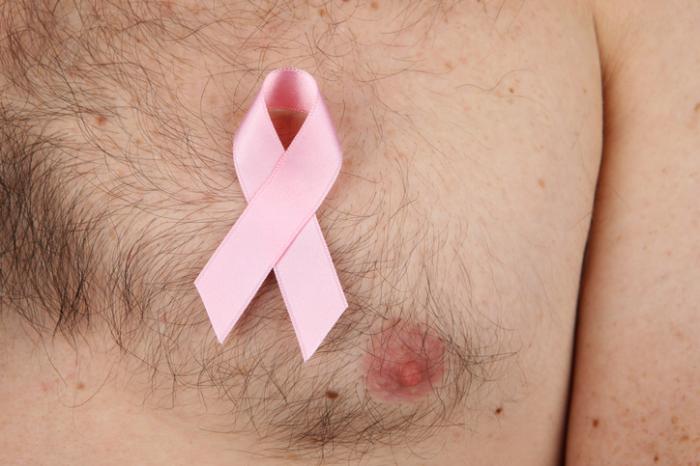 Even though breast cancer is rarer in men, both men and women should speak with their doctors about their risk of developing the disease. Preventative care can help—knowing what to look out for can mean the difference between making lifestyle changes and undergoing treatment for a life-threatening illness.
Even though breast cancer is rarer in men, both men and women should speak with their doctors about their risk of developing the disease. Preventative care can help—knowing what to look out for can mean the difference between making lifestyle changes and undergoing treatment for a life-threatening illness.
These common lifestyle and genetic factors are often associated with a higher likelihood of the disease:
- Aging
- BRCA1 and BRCA2 genetic changes
- Testicular conditions
- Family history of breast cancer
- Hormone therapy treatment
- Liver diseases (such as cirrhosis)
- Klinefelter syndrome,
- Obesity
- Radiation exposure
If you present one or more of these risk factors, speak with your doctor about early breast cancer detection and treatment options.
At Central Florida Cancer Care Center, our specially trained experts can provide you with the care you need to stay healthy and cancer-free. From early diagnostics to long-term treatments, we offer comprehensive medical support to lower your risk of developing cancer and manage your condition if and when issues arise.
Speak with one of our team members today to schedule an exam.

